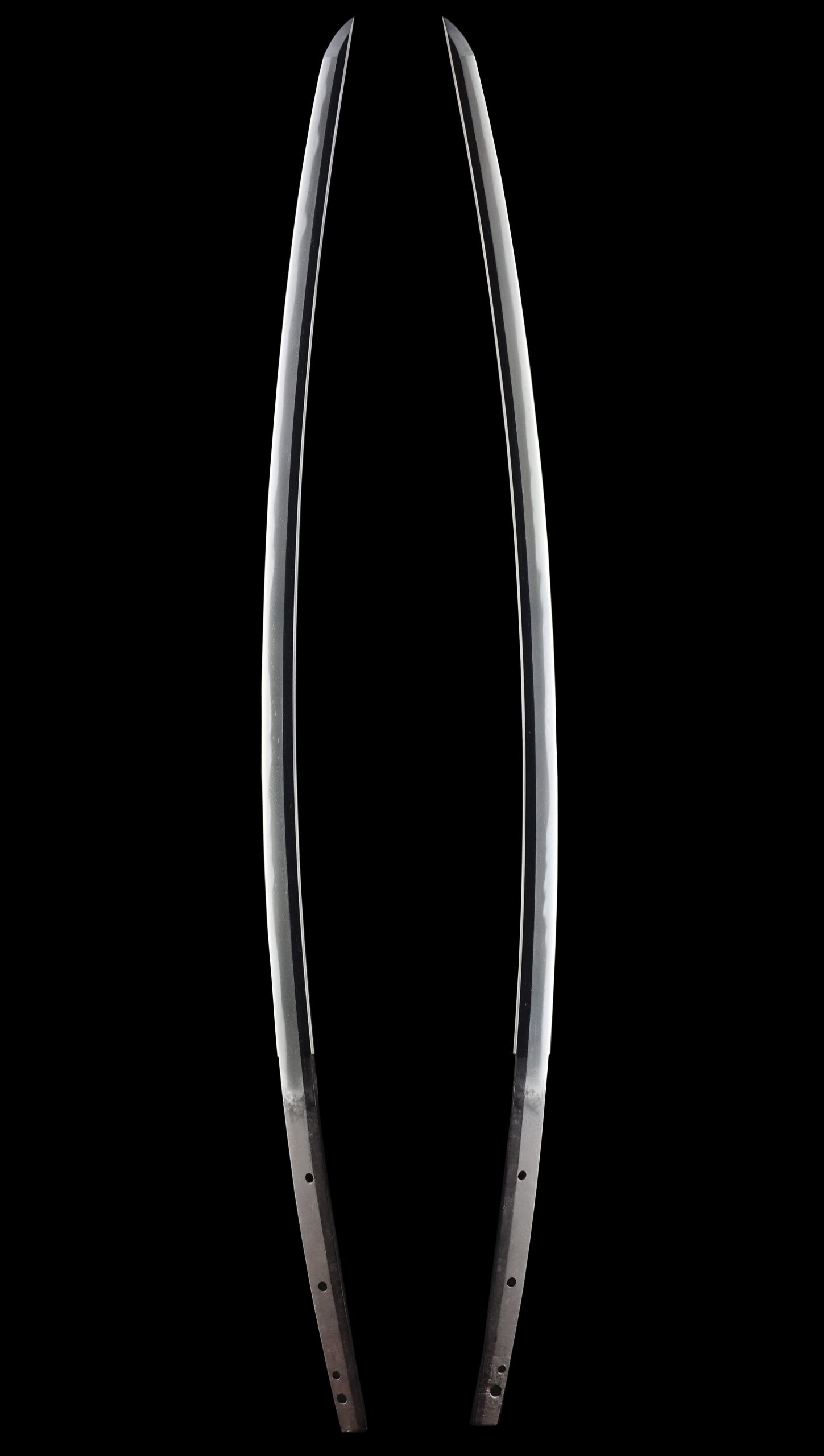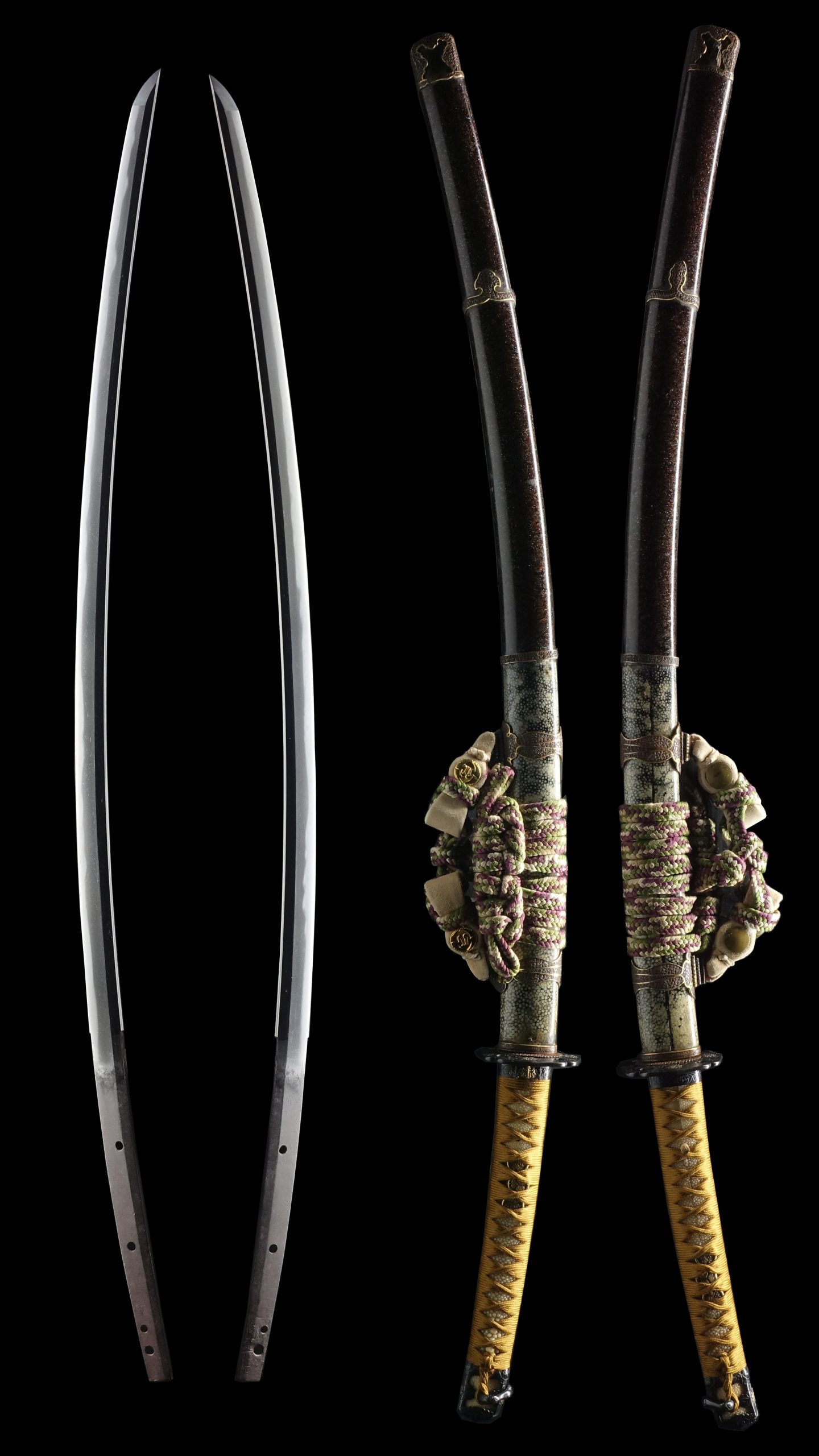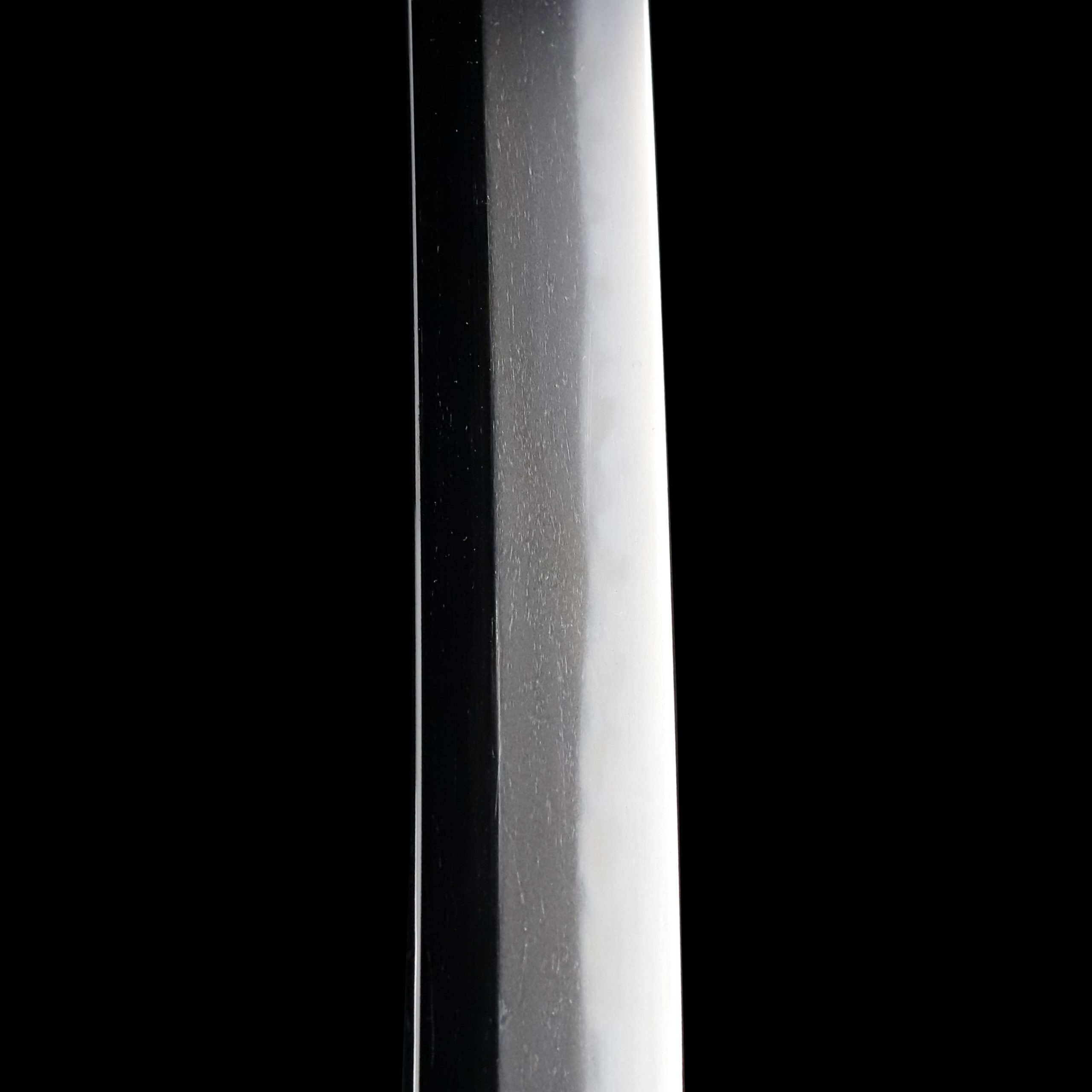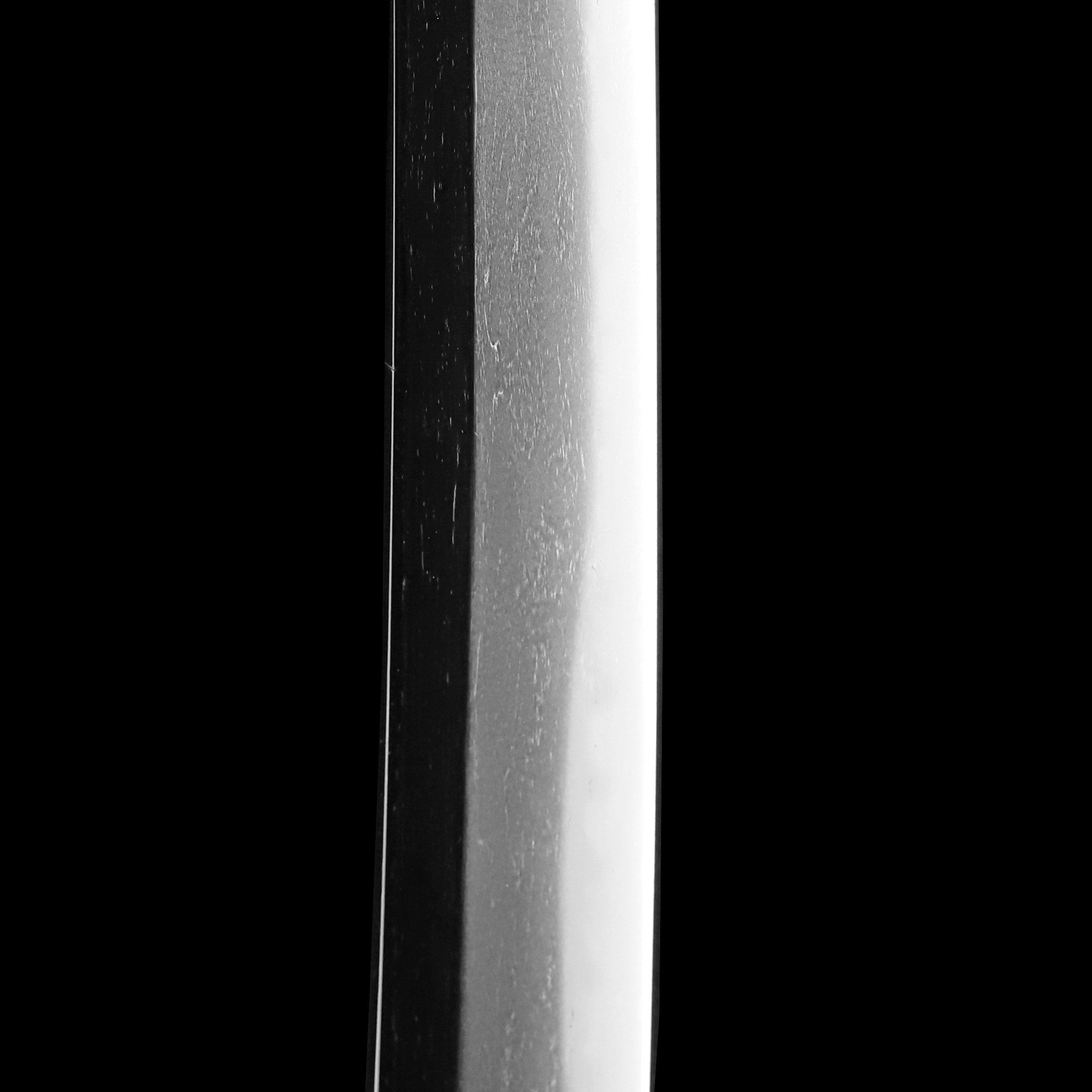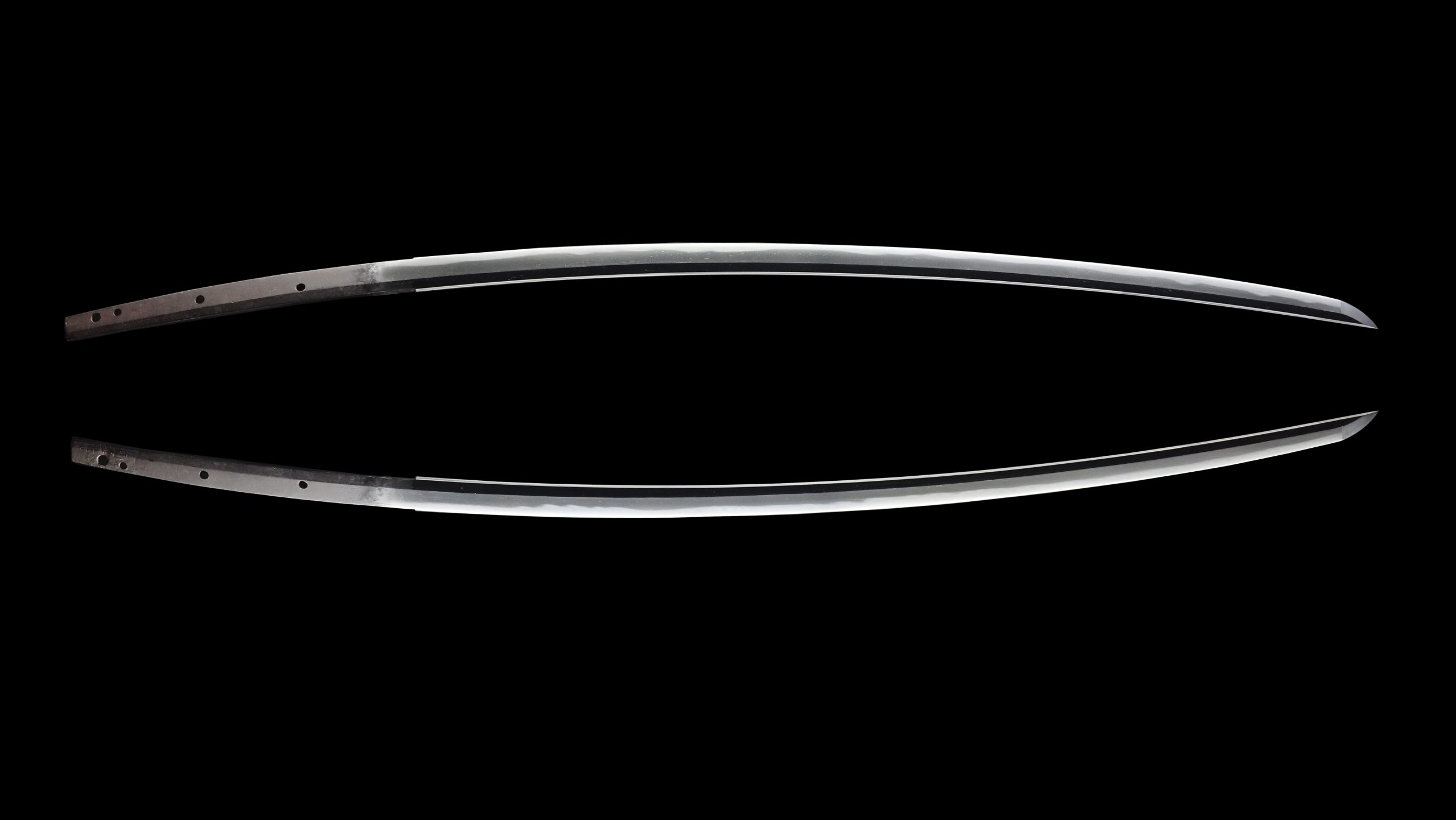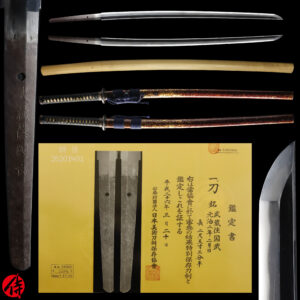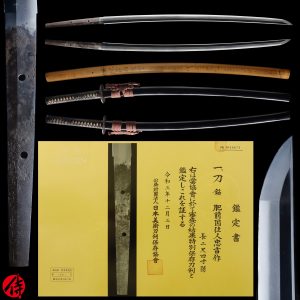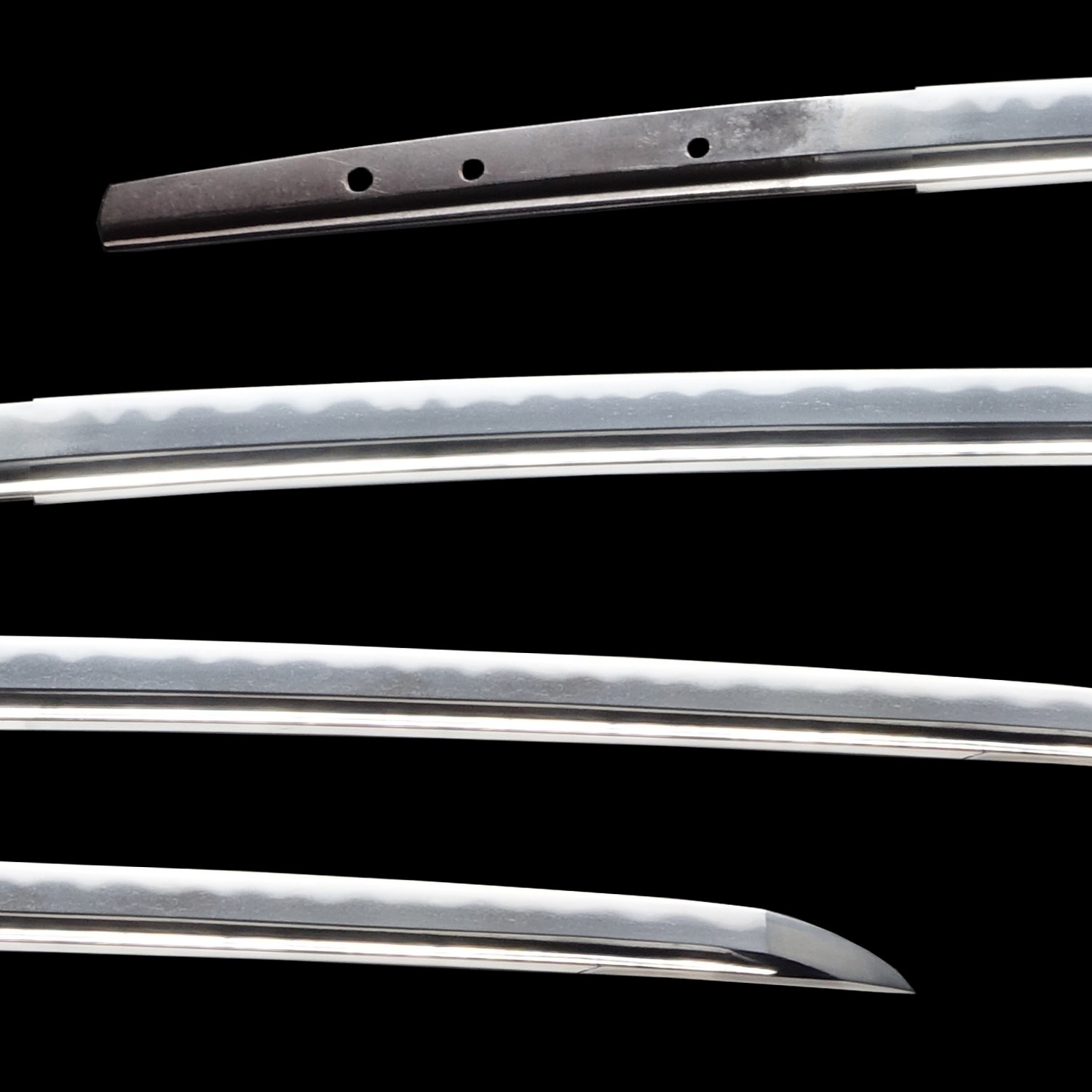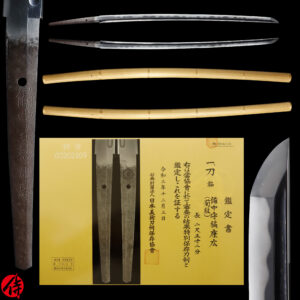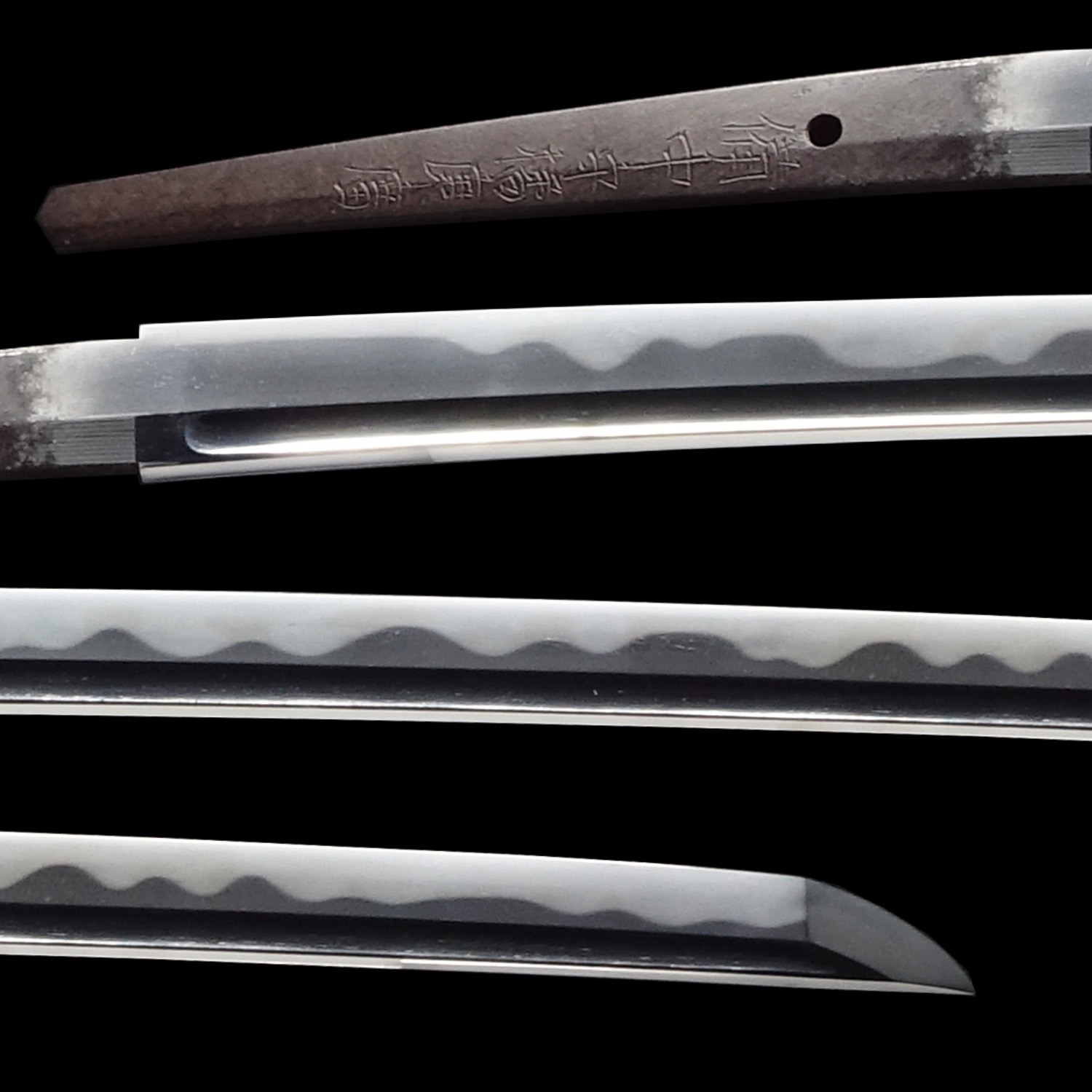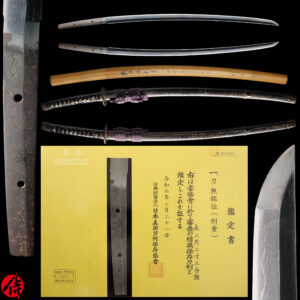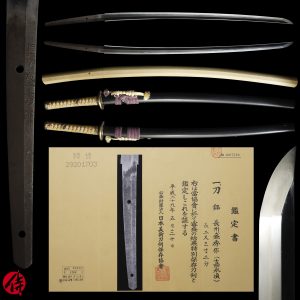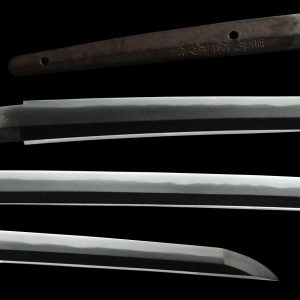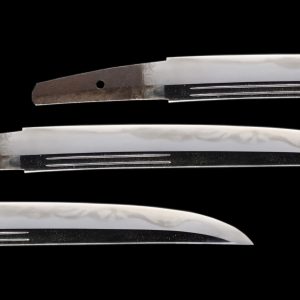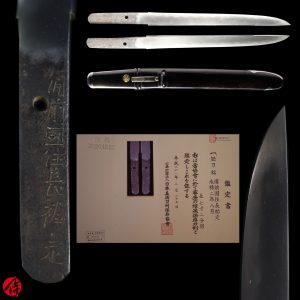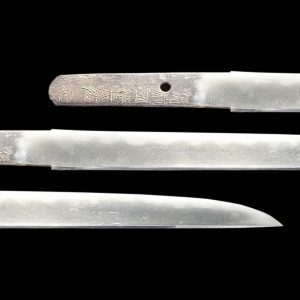Antique Japanese Sword Katana Signed by Sadamitsu with Tokubetsu Hozon Certificate
【Description】
Summary
This blade was signed by Sadamitsu (貞光) during the early Muromachi period (Mid-Late 14th century), according to its NBTHK appraisal. NBTHK Tokubetsu Hozon certificate doesn’t specify which Sadamitsu forged this blade as there were more than one swordsmiths who used Sadamitsu as their maker’s name back then. Based on the characteristic of the blade, such as Jigane(Surface Pattern on the steel), Hamon(tempering line), and the shape of Nakago(tang), they estimated the period this blade was created.
Based on the Nakago shape and the number of holes, this blade was shortened a few times in the past. We assume this blade used to be quite long but got shortened due to the regulations back then or its owner’s preferences.
Tachi blade&Tachi Koshirae
Based on which side the signature is on and the authentication paper, this blade was created as a Tachi sword. It comes with a Tachi(太刀) Koshirae.
Tachi was mainly used by an armored Samurai with one hand on horseback from the Heian period (794-1185 A.D.) until the early Muromachi period. TACHI was suspended loosely on the left waist with its edge facing the ground so that you could draw it faster to cut down soldiers on the ground.
Because of its gorgeous looking, having a Tachi-style sword mounting became a social status among Samurai. We presume this blade was owned by a high-ranked Samurai who was wealthy enough to own a blade forged by a famous swordsmith with the Tachi-style sword mounting.
Reference
There is a Saya Gaki, an appraisal written on a Shirasaya. It was appraised by Kanzan (寒山), a reputable Japanese sword expert (1907-1978). The Saya Gaki was done in 1976. According to this appraisal, this blade was signed by Yamato Koku Sadamitsu (大和国貞光). As a reference, we will write the description about this swordsmith. Yamato Sadamitsu was active during 1346-1370 (early Muromachi period), based on available records. He belonged to Hosho (保昌) school in Yamato province (Today’s Nara prefecture).
There were five prestigious schools, including Hosho school, during the Kamakura-early Muromachi period in Yamato province. They are called Yamato Goha(大和五派); Senjyuin(千手院), Shikkake (尻懸), Taima(当麻), Hosho(保昌) and Tegai(手掻) school. They served politically powerful monks and temples in Nara, such as Todaiji temples. They were initially forging swords for military monks who became powerful due to the government’s policy back then.
Monks needed many weapons as there were many political rivalries between influential temples. They required strong weapons like swords to protect themselves. During this time, Tegai school or other Yamato sword schools met the requests from monks. They also forged blades for Samurai during their heyday.
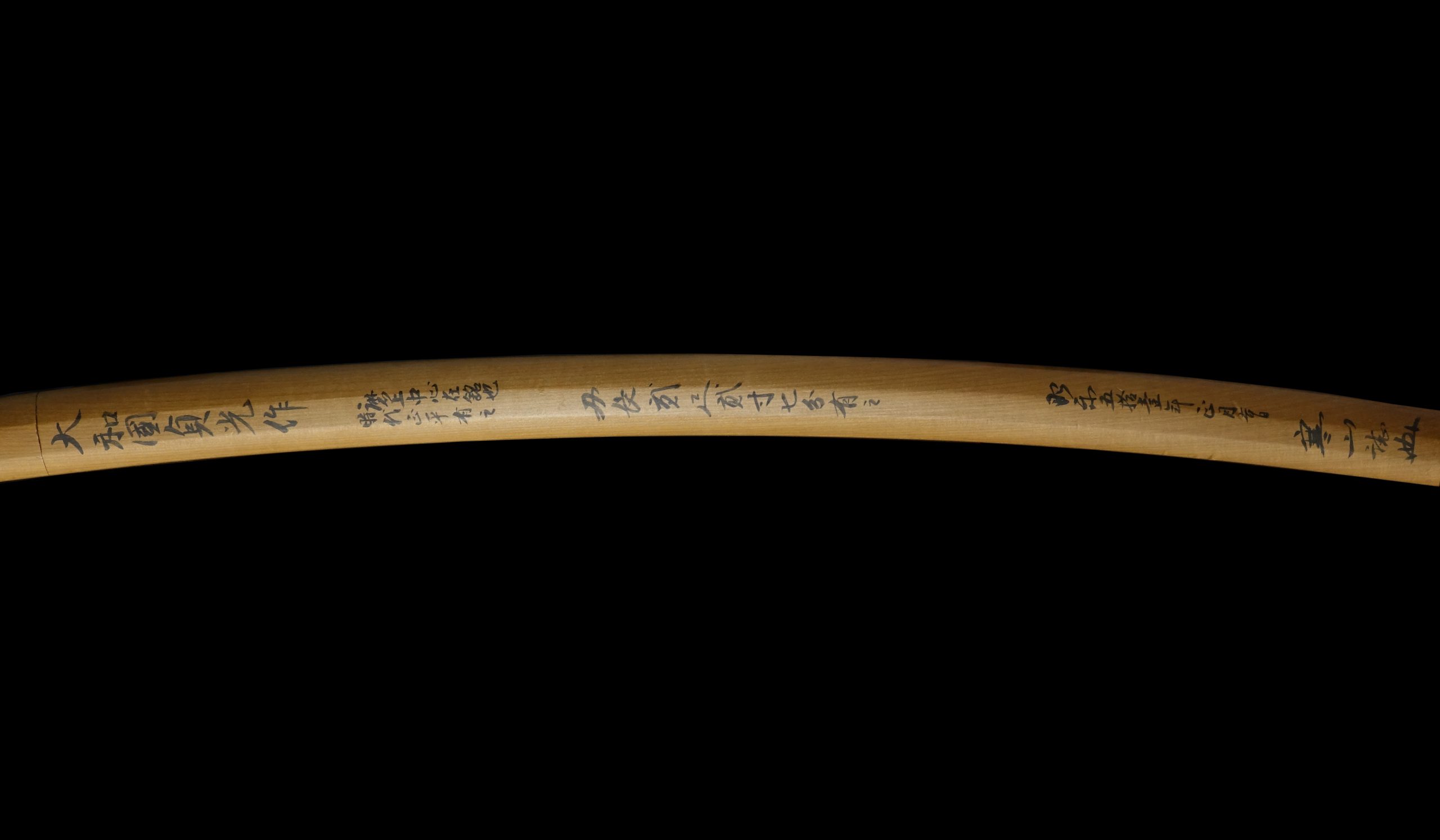
It is appraised as a Tokubetsu Hozon Token(特別保存刀剣) issued by NBTHK(Nihon Bijutsu Touken Hozon Kyokai:日本美術刀剣保存協会). This authentication paper was only given to authentic Japanese swords, especially well preserved and high quality with artistic value.
【 Blade】
Cutting Edge Length(Nagasa):68.6 cm(27.0 inches)
Curvature(Sori): 2.5 cm (0.98 inches)

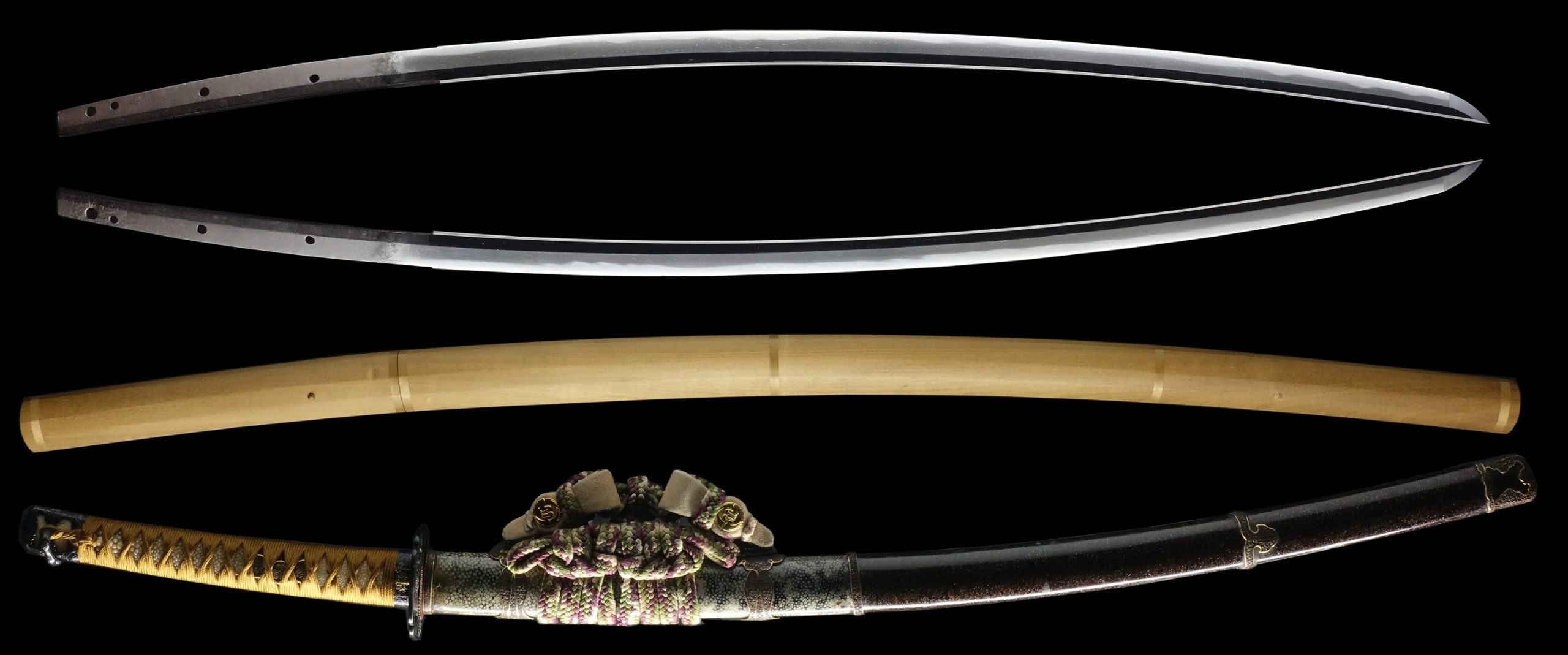
Hamon:
The crystalline structure which forms along the cutting edge of a blade as a result of the hardening process
Jimon(Jihada):
visible steel surface pattern created by folding and hammering during forging process
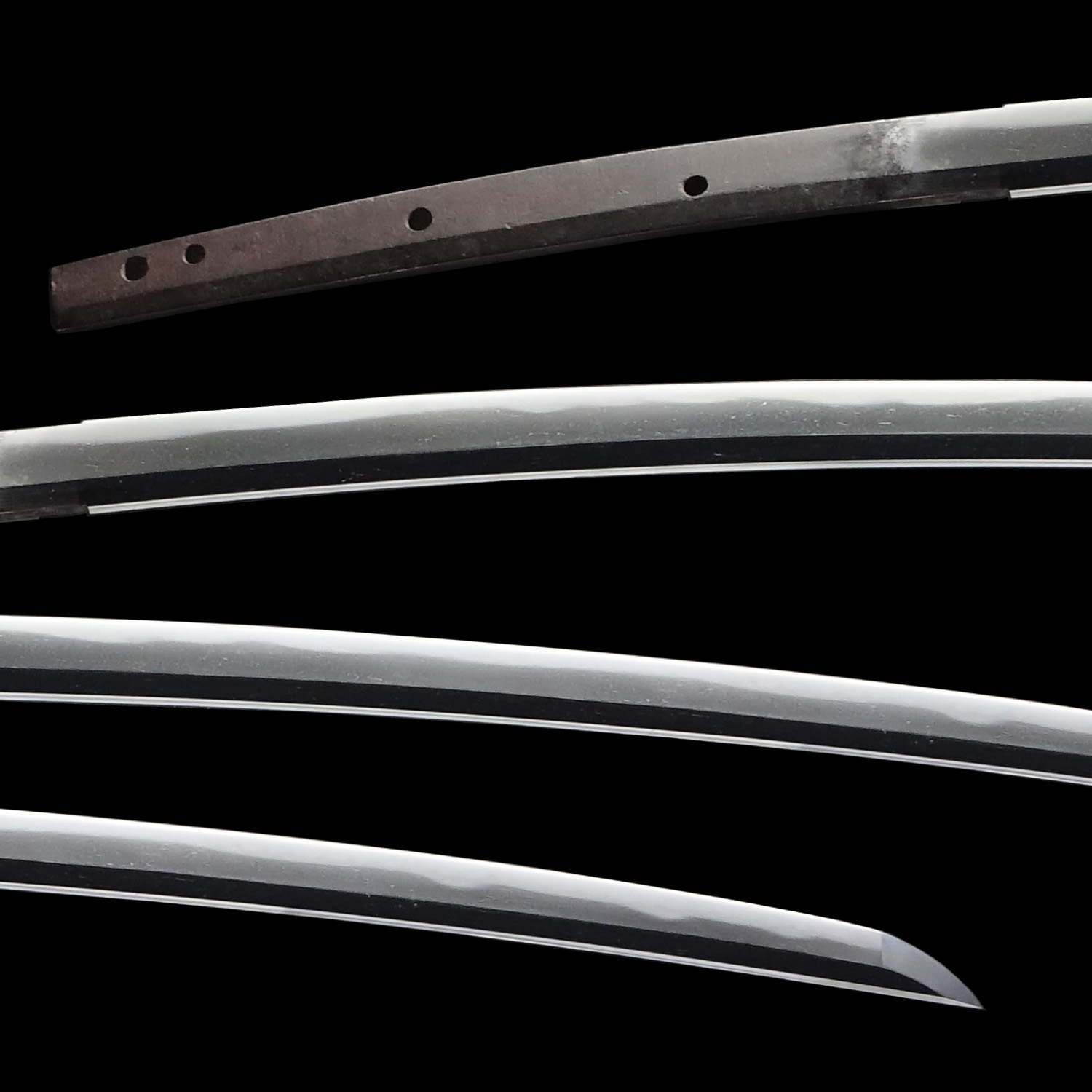
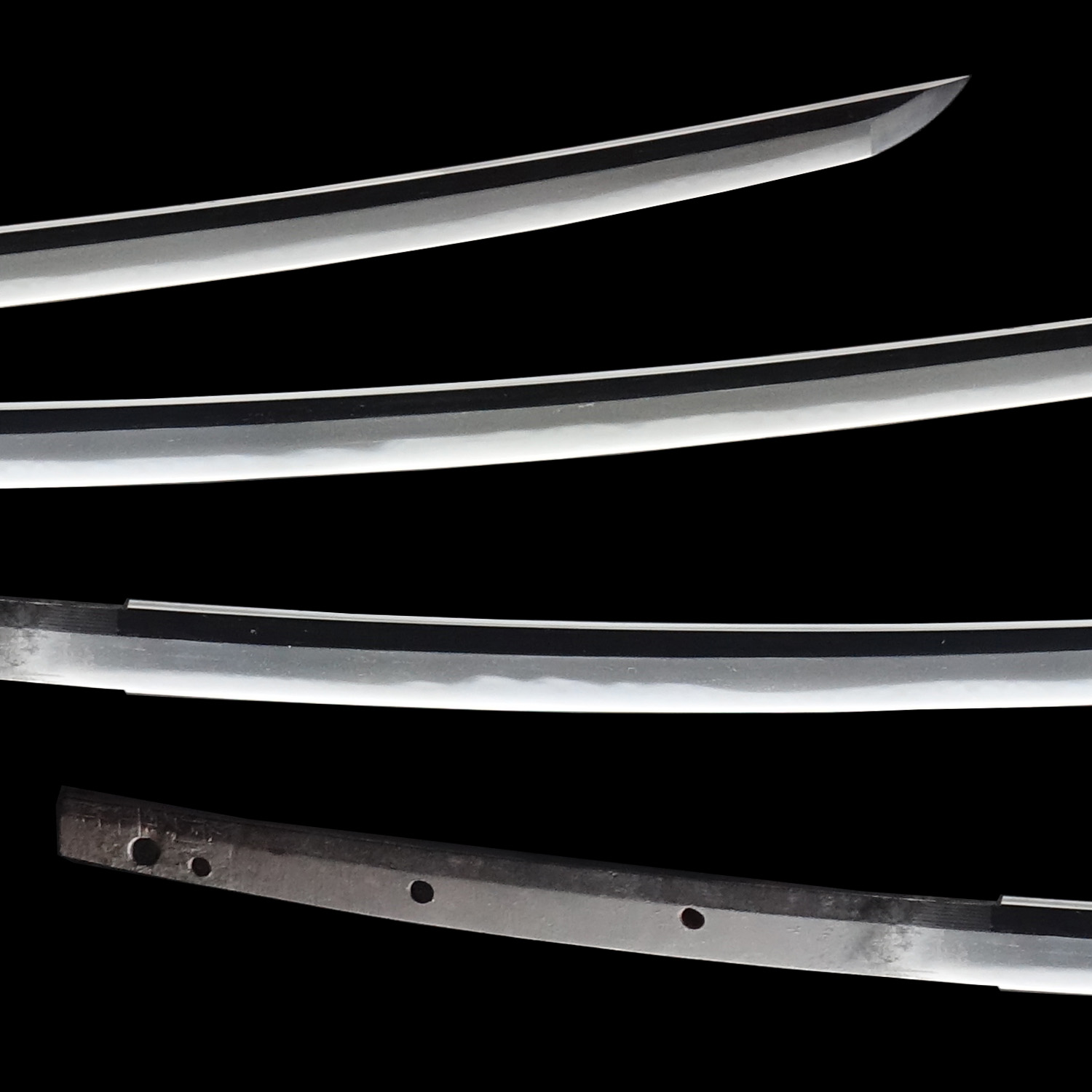
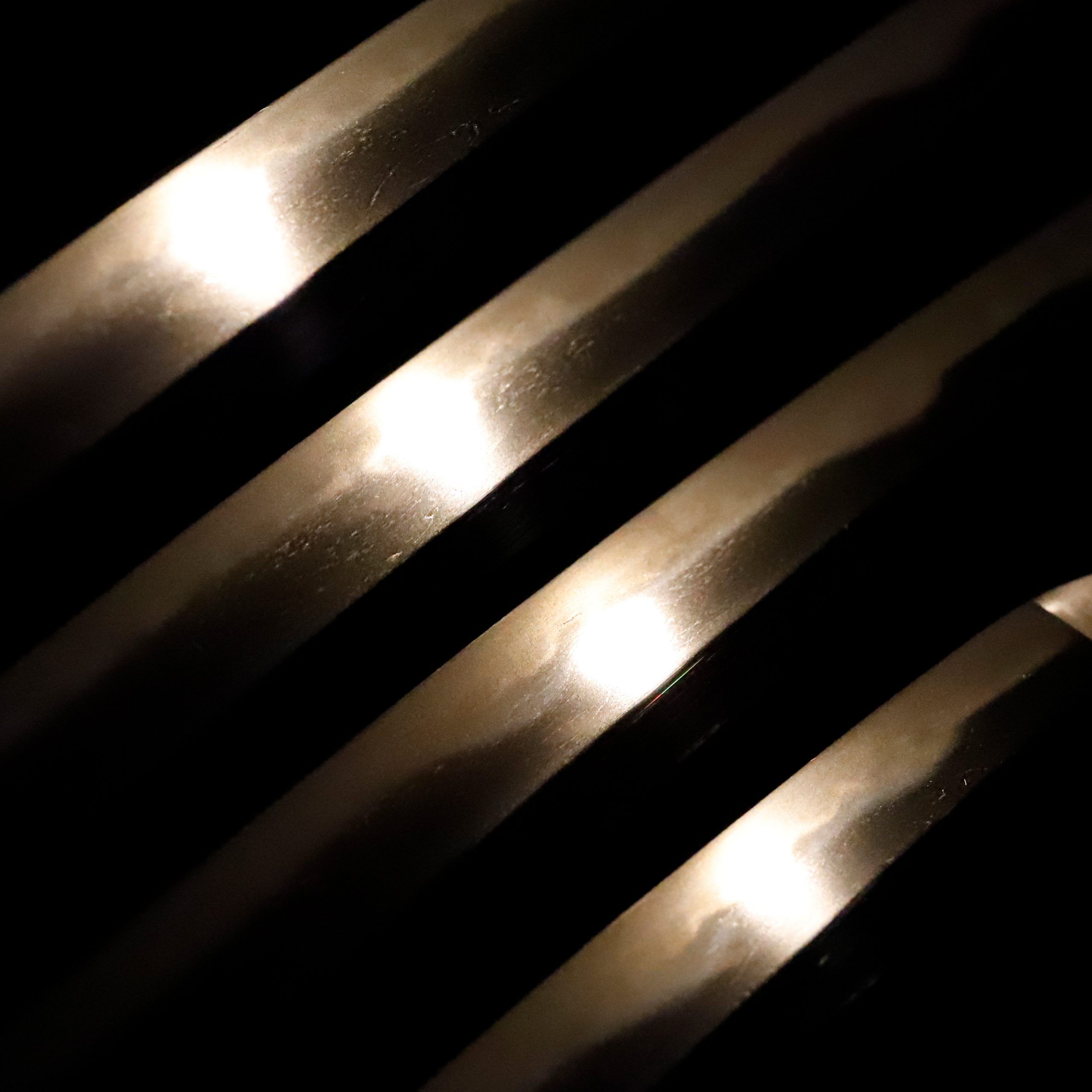
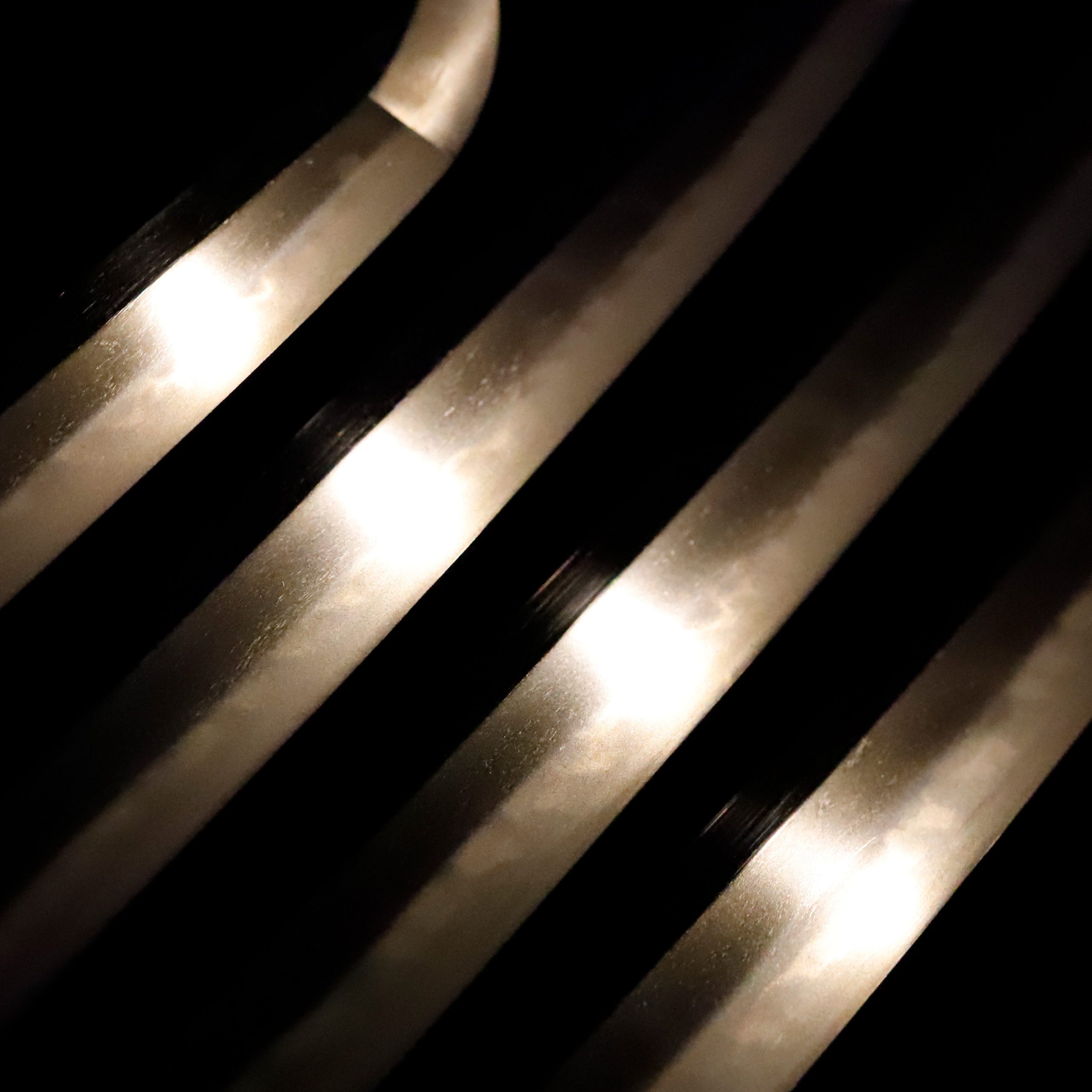
Nakago:Nakago is the tang of the Japanese sword.
Japanese swordsmiths left the black rust on the tang because it prevents red rust while the tang is in its handle. And the discoloration of the tang was created over time, and it is a great indicator for a Japanese sword specialist to estimate when the sword was forged.
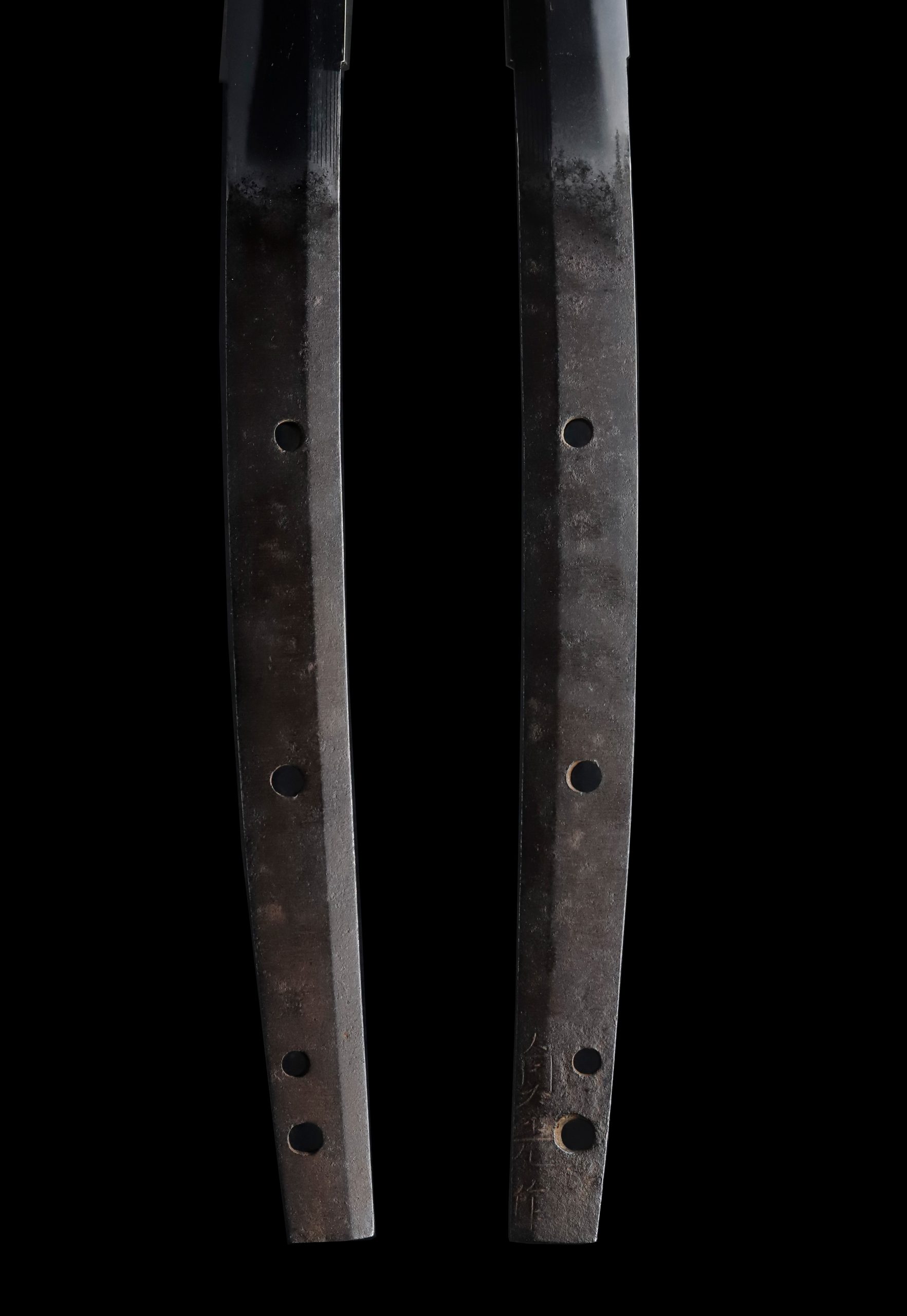
Koshirae: Koshirae is the mounting of the Japanese sword. There are several parts that consist of Koshirae such as Saya(Scabbard), Tsuka(Handle), Tsuba(Handguard).
If you focus on each part of this Koshirae, you will find that all the sword mountings are decorated with the Kiri (桐, paulownia) motif. As you see in this Koshirae, the Gosan-no-Kiri Monyou (五三の桐文様) is a popular design where the paulownia motif is used. According to a foreign tradition, Houou (鳳凰, Fenghuang, a kind of sacred beast) rests its wings on paulownia trees; therefore, it is regarded as a sacred plant.
The Kiri (桐) pattern is generally composed of three standing straight inflorescences and three leaves. The number of flowers blooming at each inflorescence shows the ranks of this design. It is also famous that one of the most popular Samurai in Japan: Toyotomi Hideyoshi (豊臣 秀吉, 1537-1598), used the Kiri pattern for his family crest. A theory says that Hideyoshi initially used the Omodaka (沢瀉, arrowhead) pattern as his family crest. However, Oda Nobunaga (織田 信長, 1534-1582), a well-known military commander in the Warring States period, permitted Hideyoshi to use the Kiri design. After the fall of the Muromachi Shogunate and the defeat of Nobunaga at the Honnouji (本能寺) temple, the reign of Hideyoshi finally started. Hideyoshi used this plant motif in various items such as clothes, furniture, decorations of his buildings, etcetera.
Moreover, he bestowed the Kiri crests to his subordinates with the clan name Hashiba (羽柴, Hideyoshi used this family name before the Toyotomi clan) or Toyotomi (豊臣). However, even among Hideyoshi’s subordinates, this Kiri crest was often given as a reward. However, some people began to use this family crest without permission, such as by borrowing or stealing it. In response to this situation, Hideyoshi enacted a law to limit the use of the Kiri crest, but the value of this design decreased considerably. Therefore, it is said that Hideyoshi used a unique design Kiri crest called the Taikou Giri (太閤桐) pattern to distinguish it from others. Through these processes, the Kiri crest became a familiar emblem not only for the privileged class, such as influential Samurai, but also for the middle class and the general public.
This plant pattern was once used by the imperial family and national leaders of the time. Today, this plant pattern is used as the crest of the Japanese Government. We hope that by introducing a little about the transition of this family crest, you will find the history of this design and its deep connection with the Samurai culture fascinating. Please enjoy this sword’s Koshirae with its blade.
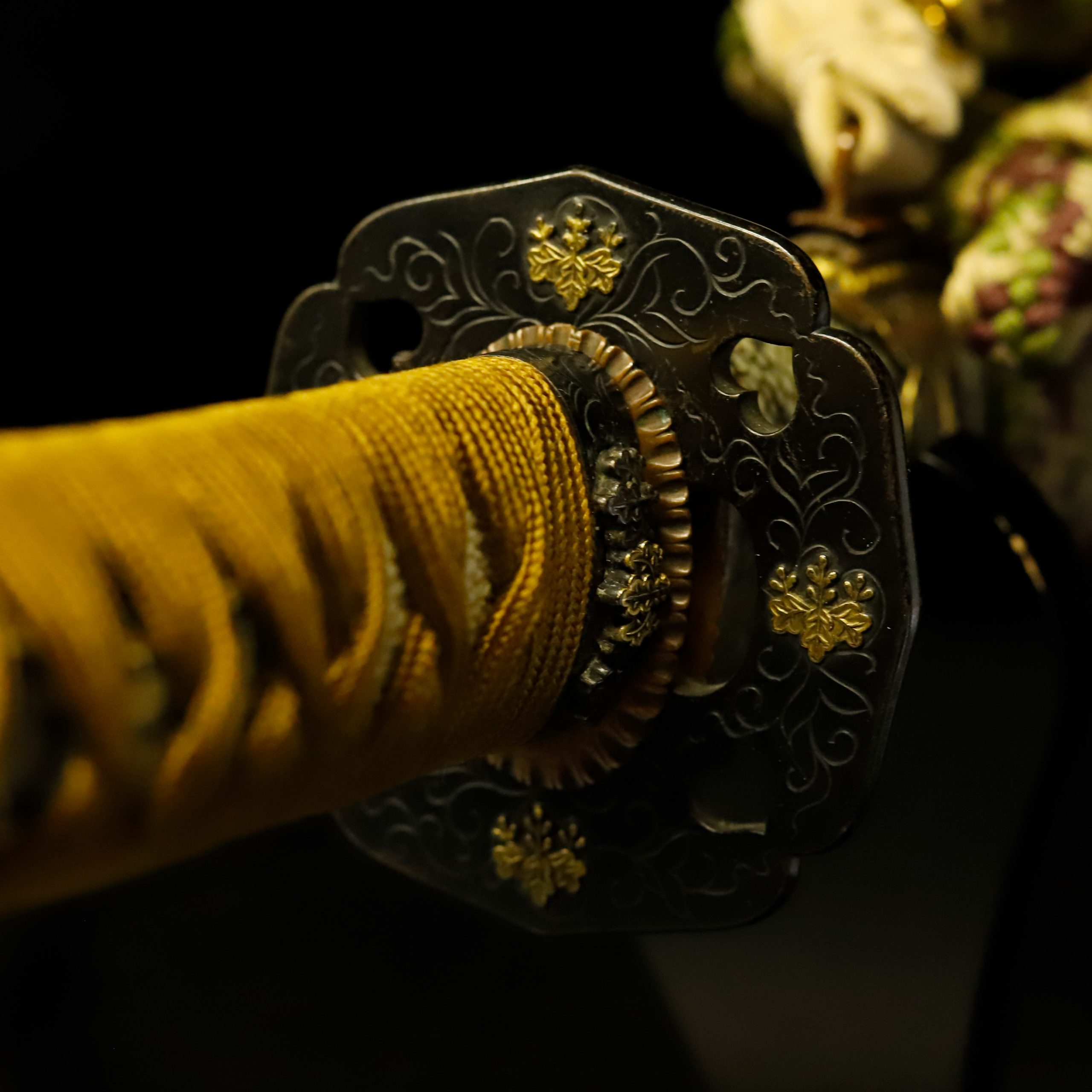
Fuchi-Kashira:A pair of matching sword fittings that cover the upper and bottom parts of its sword hilt.

Tsuka and Menuki:Tsuka is the handle of the Japanese sword and Menuki is its decoration.
You could see that this Menuki consists of three family crests. Two of them are the Gosan-no-Kiri Monyou crests, the same as other sword mountings. And another one (center one) is the Aoi-Mon (葵紋) and is composed of a plant: Futaba-Aoi (フタバアオイ, Asarum caulescens). This design is well-known as the family crest of the Tokugawa (徳川) family, who was the Shogunate family during the Edo period (1603-1868 A.D.). This design initially came from the mark of the Kamo shrine in Kyoto prefecture. After unifying Japan, Tokugawa Ieyasu (徳川 家康, 1543-1616) forbade other families from using the Aoi crest to give authority to this motif. Only a few families were allowed to use the Aoi crest, with the exception of the Tokugawa family. From this background, we assume that one of the former owners of this sword might have had some connection with the Tokugawa family.
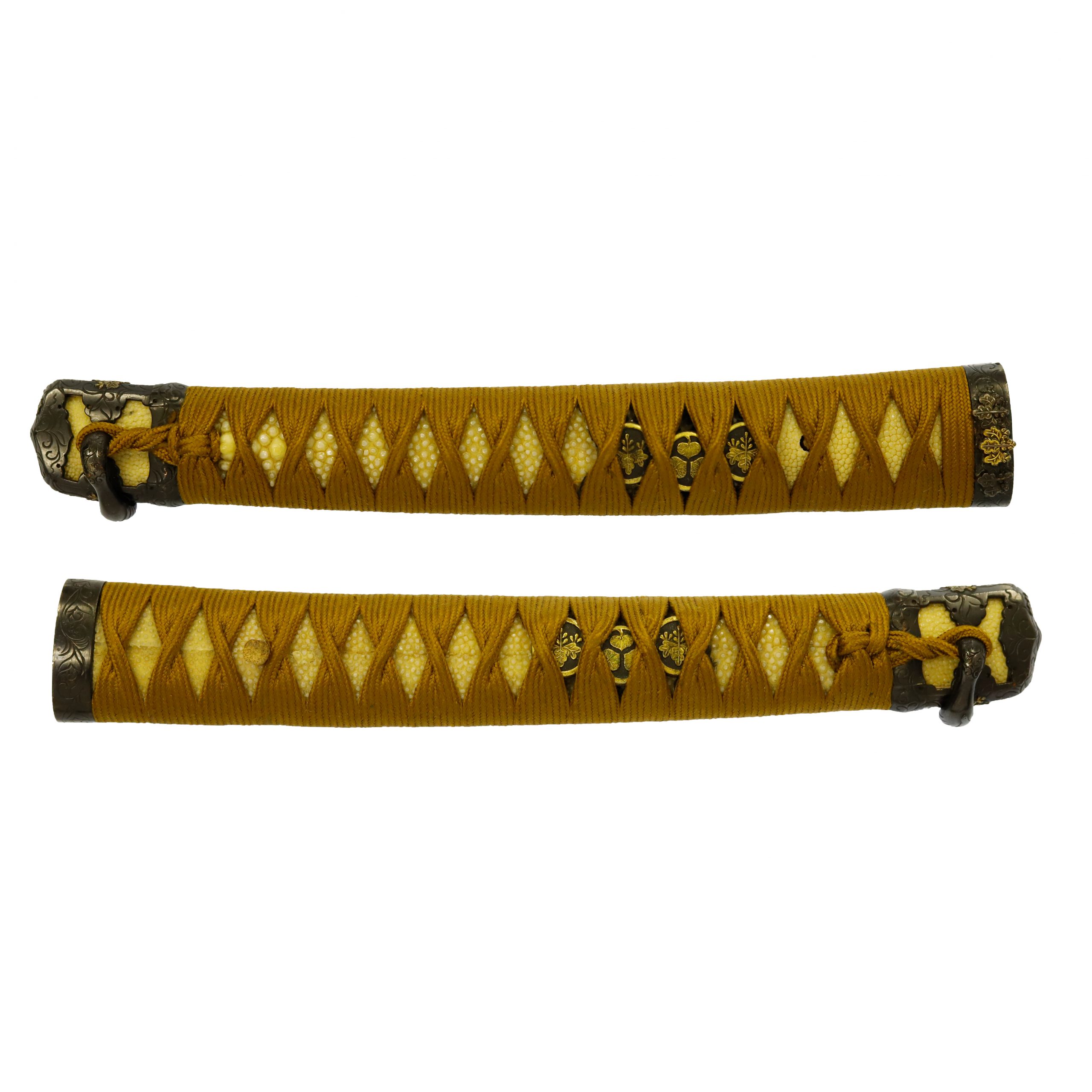
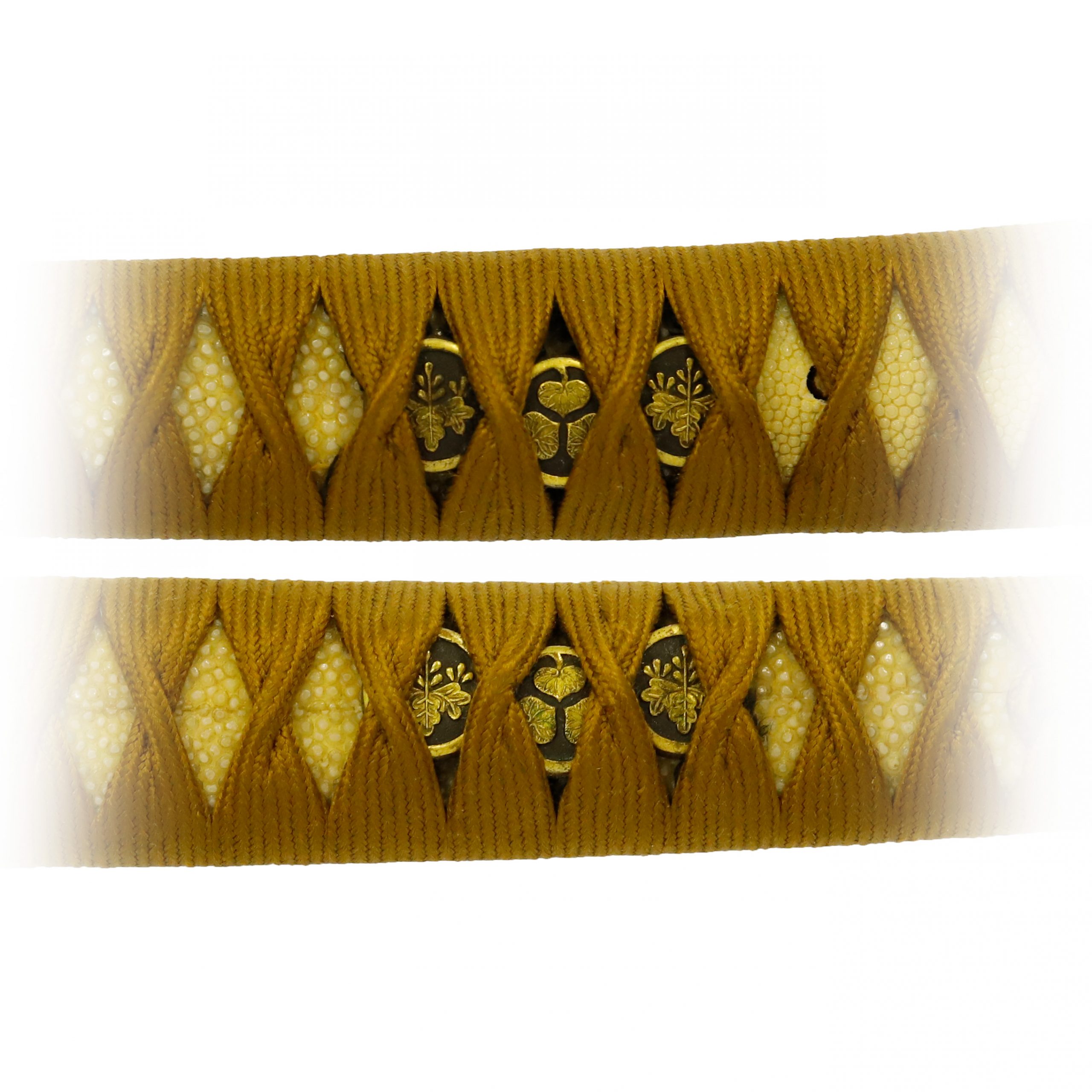
Tsuba and Habaki:Tsuba is the handguard for the Japanese Sword and Habaki is the equipment to make the blade not touch its scabbard inside. It prevents the blade from getting rusty and chipped.
As mentioned above, the Gosan-no-Kiri Monyou is designed on this Tsuba. Now please focus on four corners of this Tsuba. You would find a heart mark-shaped hole at each corner. It is called the Inome (猪の目) pattern, and it has been used since ancient times. Its name implies that the boar’s eyes are the origin of this pattern. Some people believed the Inome pattern would work as an amulet to protect them from evil spirits or fire. Also, it is said it would bring good luck. We would say that this design was probably incorporated to add decorativeness to works and religious ideas.
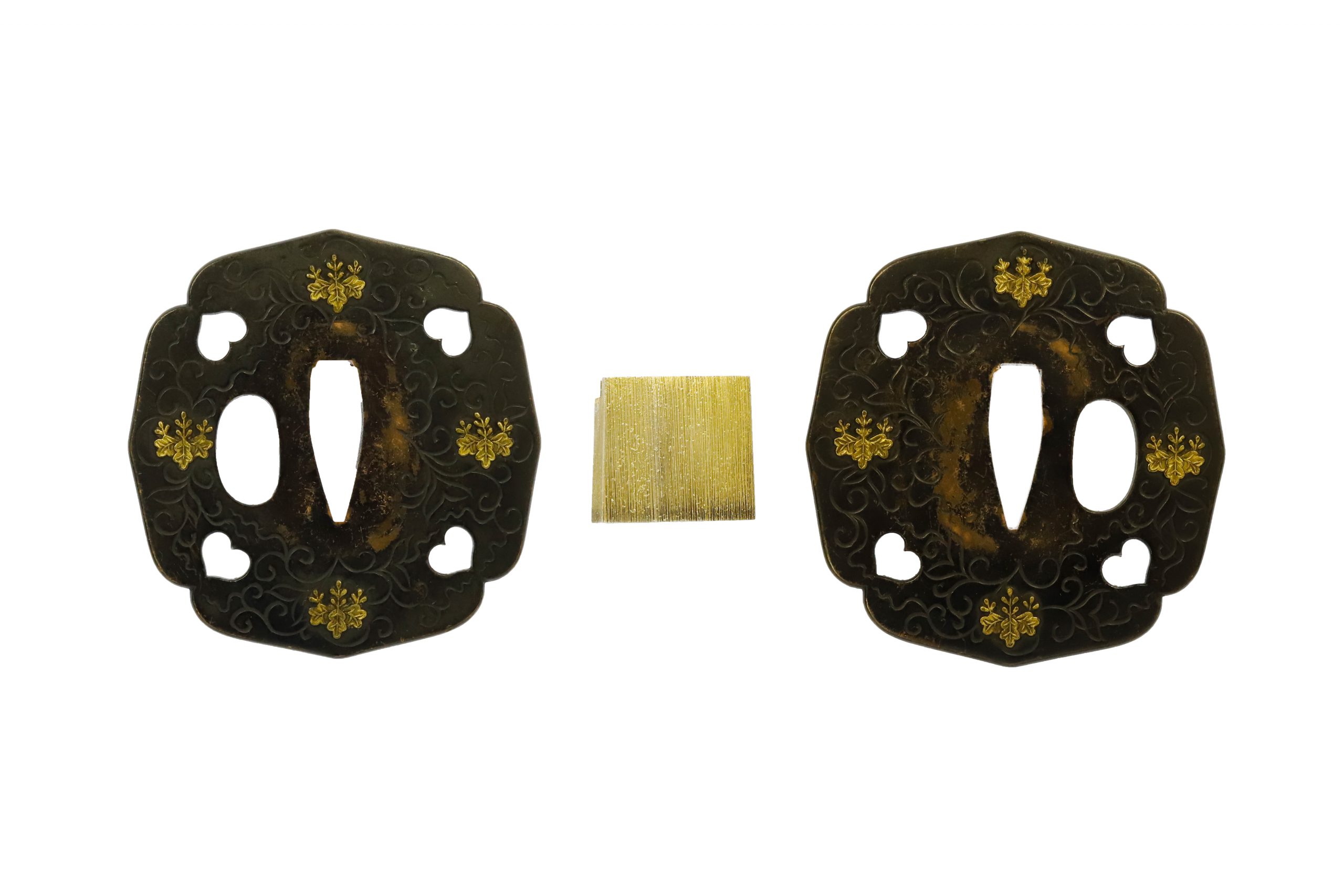
Saya: Saya is the scabbard for the Japanese sword.
The Samegawa (鮫皮/鮫革, stingray skin) is used for a part of this scabbard. This decorative finish is achieved by applying black lacquer to the gaps in the stingray skin and scraping off the protrusions on the surface to create a smooth surface.
Other than the stingray skin part, crushed seashells are used for decorating this scabbard. We think it is a type of the Raden (螺鈿) technique. It is a kind of decorative technique that is often used for traditional craftworks. It uses the pearl part of seashells and puts it into the engraved surface of lacquer or wood. Thanks to its iridescent luster, it gives a luxurious look to works, as seen in this scabbard.
Please look at the Asima (足間) part. You would find that the golden metal fitting is attached to the Taiko Gawa (太鼓革). This circle-shaped metal part is called the Taiko Gane (太鼓金) or Bunkin (文金). Generally, a family crest is designed on it. In this work, it seems that two cranes face each other. The crane has been a popular motif of family crest since ancient times. There is a proverb that says that cranes and turtles live long life. It says cranes have even one thousand years lifespan; therefore, cranes and turtles have been considered the symbols of longevity or prosperity of descendants. According to a theory, crane-designed family crests were especially favored during the Edo period among vassals and ministers, and a variety of crane pattern was made at that time.
*Please keep in mind that there are some parts where lacquer came off due to its age. If you like to see the detailed condition, please feel free to contact us.

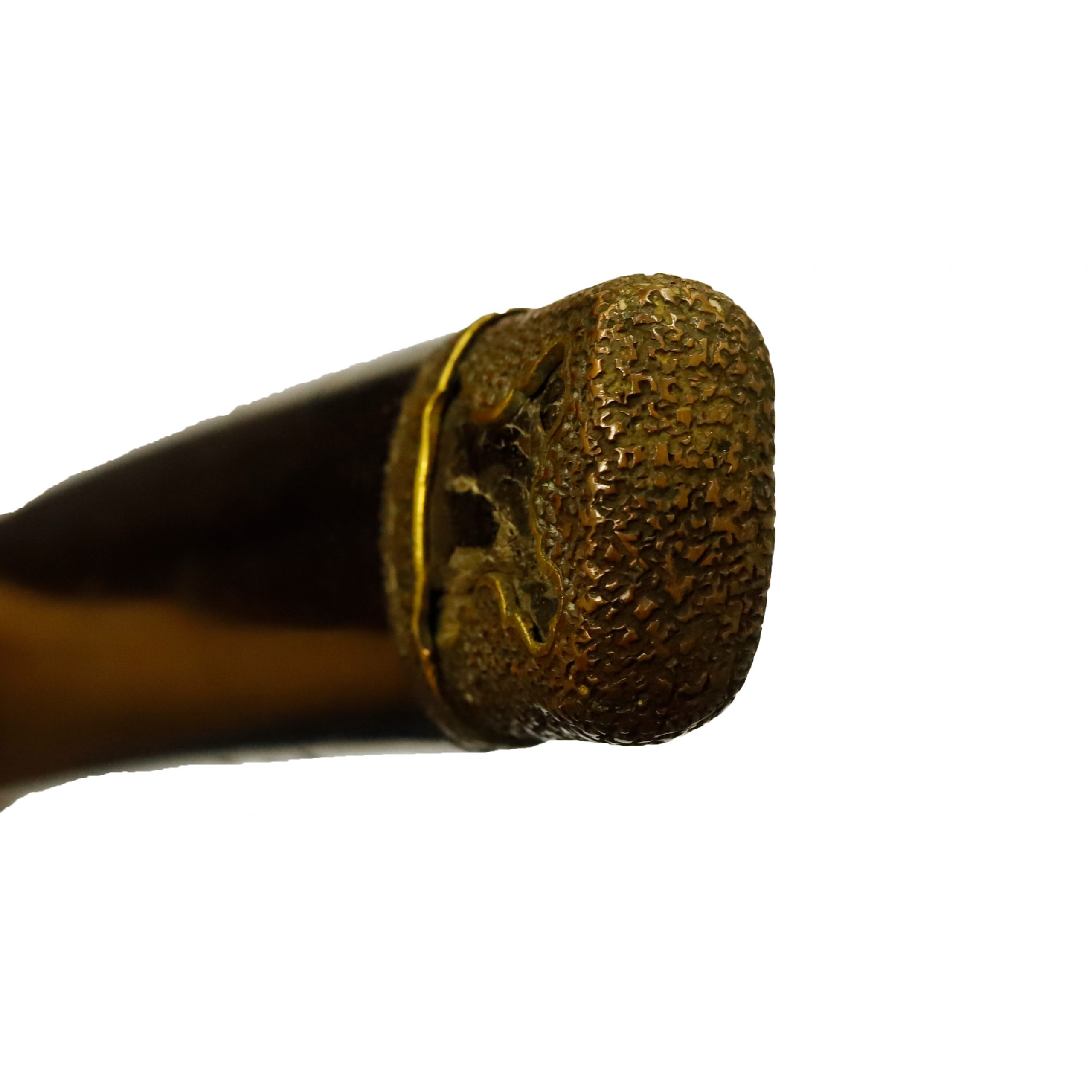
Authentication Paper:NBTHK TOKUBETSU Hozon Certificate for the blade (No. 1013749)
NBTHK, also known as Nihon Bijutsu Touken Hozon Kyokai (the Society for the Preservation of the Japan Art Sword), is one of the oldest Japanese sword appraising organizations in modern-day Japan. They authenticated the blade on Aug. 28th in the 2nd year of Reiaw (2020). They appraised it as Tokubetsu Hozon Touken, the blade especially worth preserving for Japanese society. The purchaser will receive this original certificate as well. We can also translate what is written into English and make a PDF file for your record if you request.
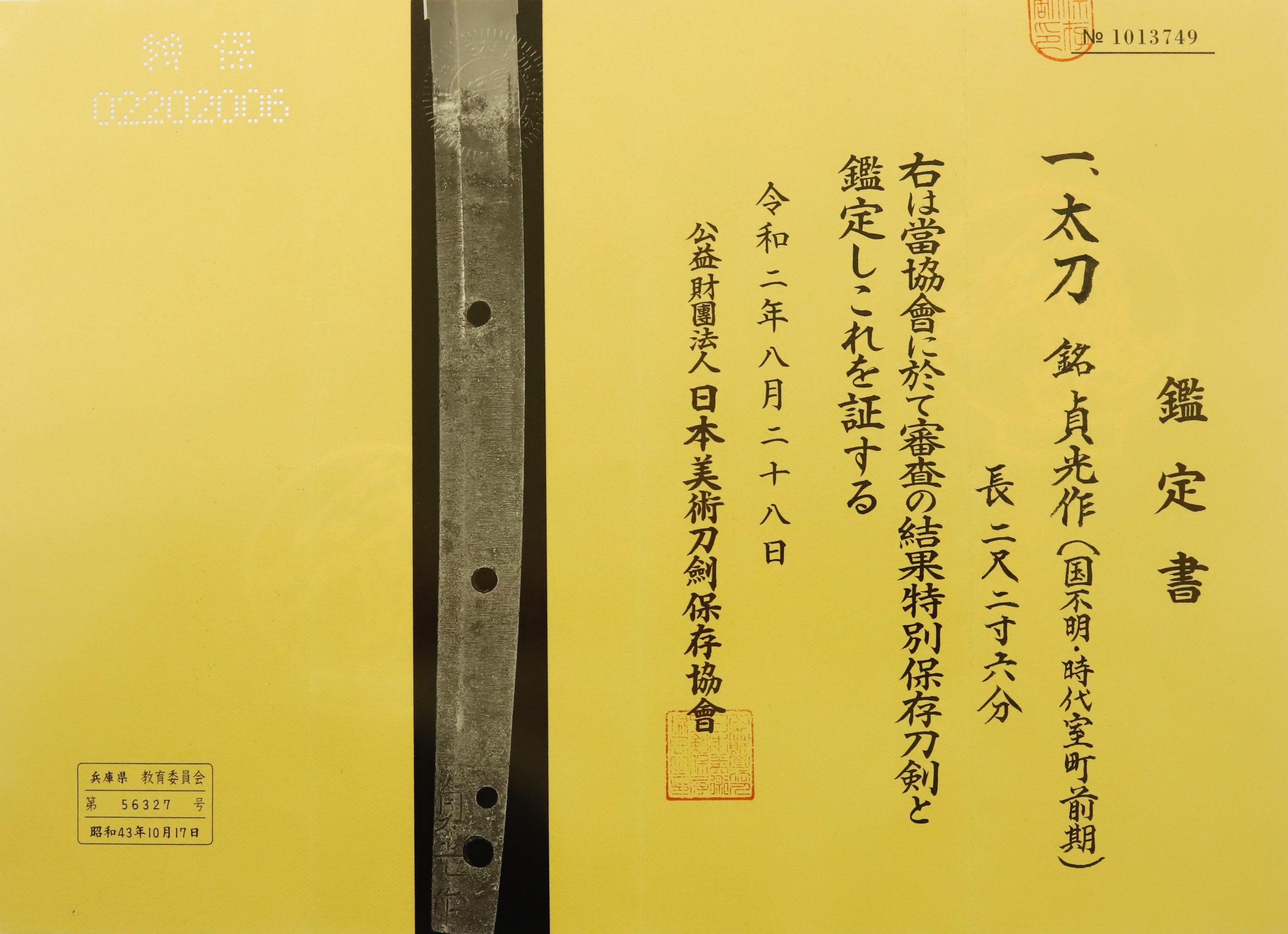
Registration Number : Hyogo 56327
The Board of Education in Hyogo prefecture issued a registration paper for this sword . It is called Jyu Token Rui Torokusho(銃刀剣類登録証). Bunkacho(The Agency for Cultural Affairs) acknowledges a Japanese sword with this paper as a work of art.
The sword needs to be traditionally hand-forged and made of Tamahagane carbon steel to be registered in the system. With this paper, its owner in Japan can legally own an authentic Japanese sword. Based on this registration number, we will apply for its export permit.
This paper will need to be returned to the board of education when the sword is being shipped abroad, but you can receive a copy of it. An English translation of this registration paper is available on request.
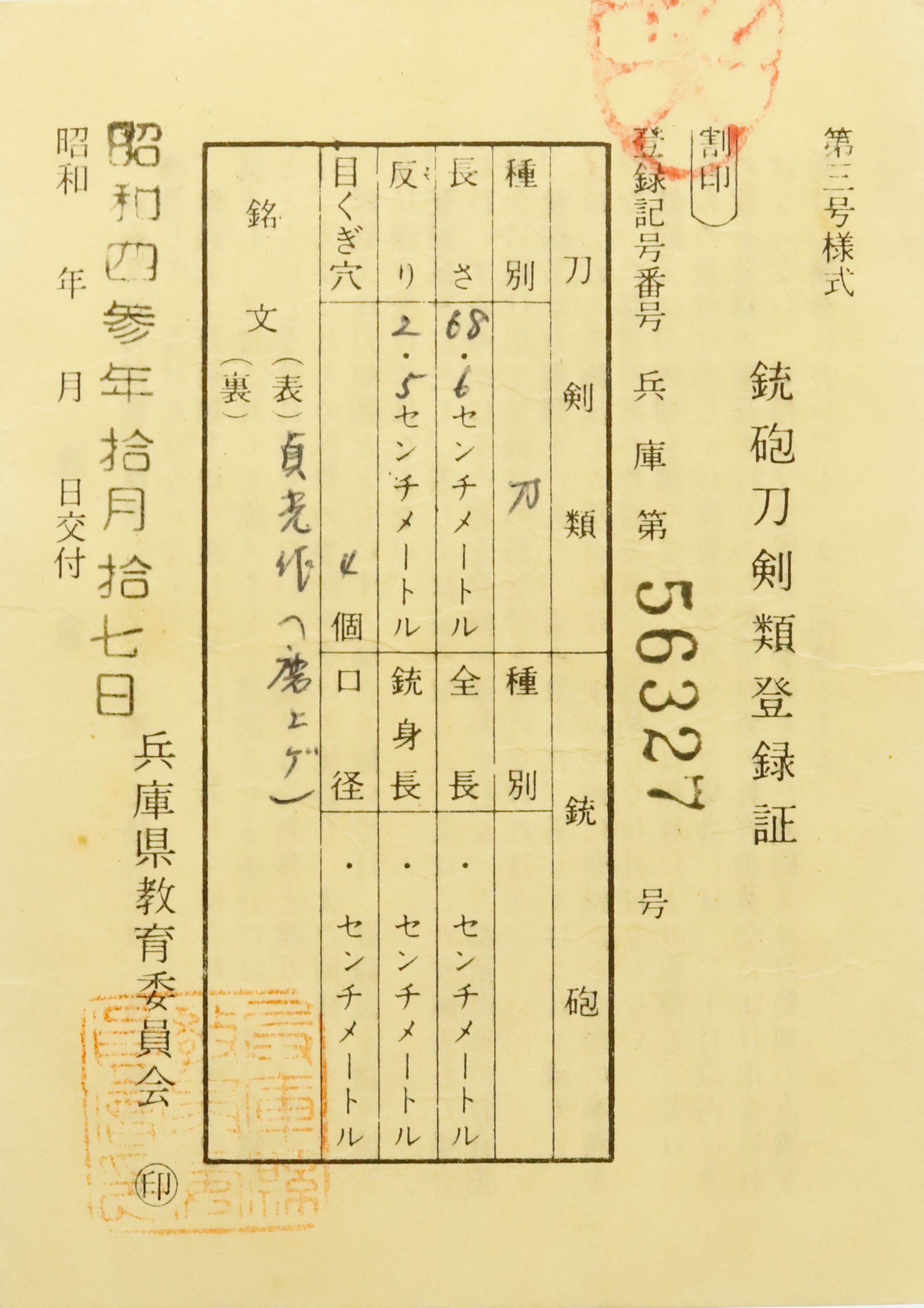
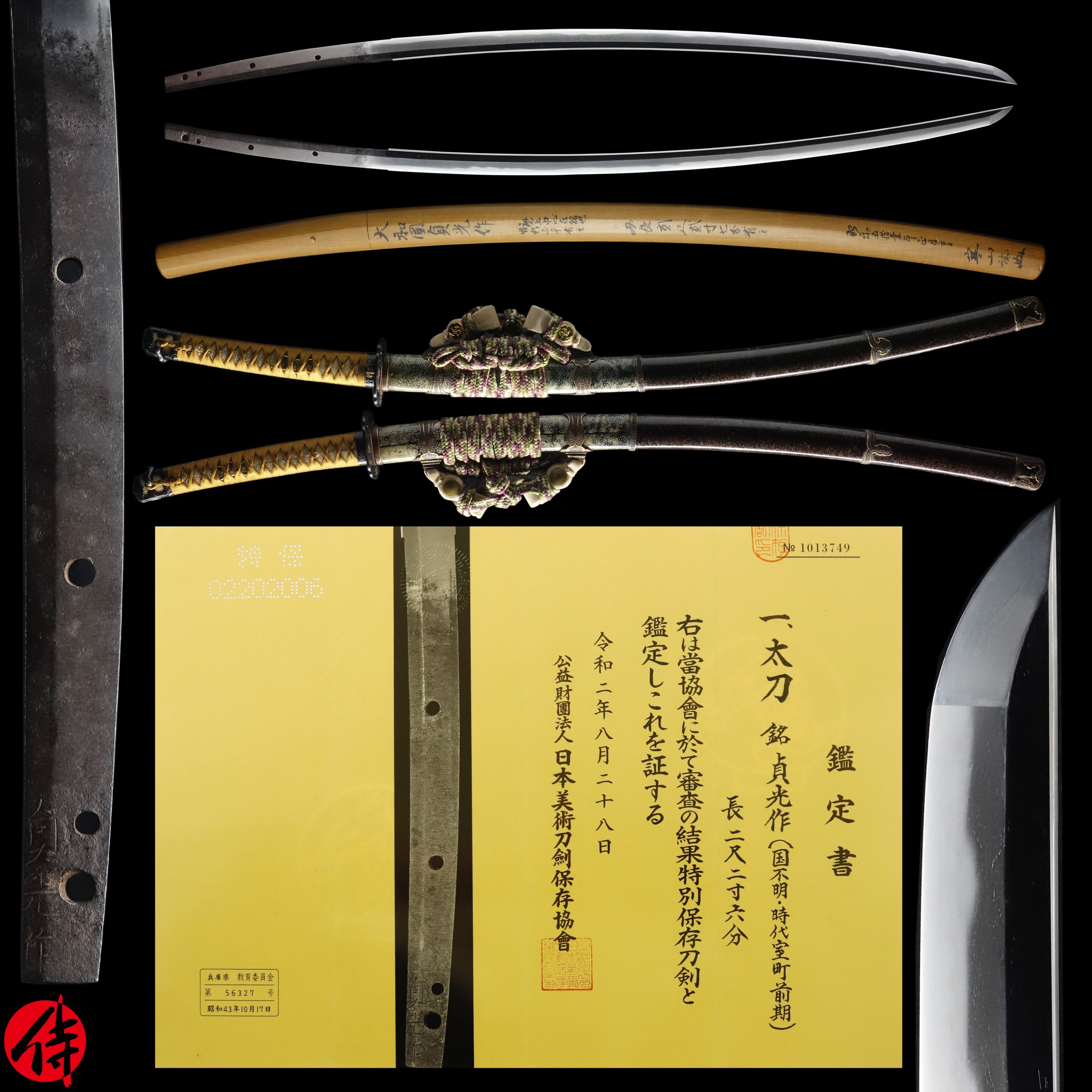
—————————————————————–
【About us】
Samurai Museum is located in Tokyo, Japan, exhibiting antique artifacts related to the Samurai history. Samurai Museum Shop is the place for those who are interested in Japanese culture and craftsmanship. We deal with antique Samurai swords/armor, traditional crafts made in Japan and so on.
【Japanese Sword& Export Process】
The Japanese swords we deal with are hand-forged edged swords made in Japan. It was made from the traditional carbon steel called TAMAHAGANE(玉鋼). Samurai Museum is familiar with the proper legal procedure for an antique/ authentic Japanese sword to be exported from Japan. We have sent more than 400 Japanese swords for the past three years (~2022) to amazing owners who appreciate its historical value.
Each Japanese sword is registered under the Agency for Cultural Affairs and the Board of Education in Japan. They issue a registration paper for each Japanese sword for its owner in Japan to legally possess it. The Japanese sword with its registration paper means it was traditionally hand-forged in Japan.
To legally export the sword from Japan to other countries, we will have to apply for its permit to the Agency for Cultural Affairs(Bunkacho) and return the original registration paper to the Board of Education. It normally takes around 2-4 weeks to receive this permit after submitting required documents. And we would like you to expect at least 1-1.5 months for your order to arrive at your given address after you ordered. For more detailed info, please click here.
It is allowed for residents in Japan to own authentic Japanese swords without a special license as long as they come with registration papers. Please feel free to contact us if you are a resident of Japan, whether temporarily or permanently. We will also assist you when you leave Japan and need to obtain the export permit.
【Payment Method】
We accept payment through Stripe (Credit card), PayPal, Apple Pay or ChromePay, all of which are secure payment methods. Also, you don’t need to make an account on Stripe for the checkout. If you prefer other payment method, please contact us. After confirming your payment, we will apply for an export permit. You may either pay in JPY, USD, AUD, CAD,EUR,CHF or GBP. The price is set in Japanese Yen. Prices in other currencies are automatically calculated based on the latest exchange rate.

* If the amount is above 1 million JPY, Stripe or wire transfer will be the only options for payment.
【Shipping】
We have shipped authentic Japanese swords to the USA, UK, Canada, Mexico, Germany, Switzerland, France, Hong Kong and Australia. If you don’t live in these countries and like to order, please contact us first before making a purchase. We offer Free International Shipping as long as we can send antique Japanese swords by either EMS or FedEx(Canada).
We normally ship by EMS(Express Mail Service) provided by Japan Post. When we receive an order from the Canada we will use FedEx instead as EMS temporarily stops shipping from Japan to those countries due to COVID-19.
We will send you a tracking number for your order as soon as we hand it to the post office/FedEx. We will put 100 % insurance on the shipping document without any extra charge. Based on the total amount, there might be a duty tax or other fee for you to pay, depending on the countries. We use package cushioning to protect the item and put it in a PVC pipe, which is one of the most secure packages because of its durability.
It will normally takes 5-14 days for the item to arrive at your given address after we dispatch it. Time of delivery is estimated as accurately as possible by the carrier but does not take into account any delays beyond our control such as by inclement weather, post office holiday seasons.
* If you live in Australia and like to purchase an authentic Japanese sword, please click here to know the detail.
*Please keep in mind that due to the spread of COVID-19, there might be delays in shipping. If you like to know the detail about shipping, please feel free to ask us.

【How to make sure the condition】
Please keep in mind that what you are going to purchase is an antique item. We uploaded high resolution photos for you to check its condition thoroughly. If you like to see more photos with different angles, please feel free to contact us. We will be happy to send them to you so that you can make informed decision. It is essential for us to know that you are happy with your choice of a sword. and we are prepared to use the best of our ability to serve you.
【How To Contact Us】
Please contact us through email, Facebook Messenger or Live Chat if you have any questions. You can find each icon on the right side of the website. Please click one of them to reach us. We will reply to you within 1-2 business days.
【The Art of Nihonto(Japanese Sword)】
Samurai’s history is a profound, eloquent legacy of ancient Japanese warriors in which millions of people worldwide are being fascinated. If you like to find out the art of Nihonto, please click here.
【A Guide to Japanese Sword Maintenance】
After acquiring an genuine Japanese sword, it is also important to know how to take good care of it. Here is the special video for you. Mr. Paul Martin, Japanese sword expert, shows you how to give proper maintenance to your sword. By mastering how to clean the Japanese sword, its aesthetic beauty will last forever.
When you purchase a Japanese sword from us, you can get a Free Japanese sword maintenance kit. It comes with four tools(Choji Oil, Uchiko Whetstone Powder, Peg remover, Oil Applicator). By watching the video instruction above , you can enjoy learning how to maintain your Japanese sword while appreciating it. If you have any difficulty assembling the sword or cleaning the blade, you can feel free to contact us.


MORE ANTIQUE JAPANESE SWORD FOR SALE
SWORDS WITHOUT CERTIFICATES FOR SALE
LEARN JAPANESE SWORD TERMINOLOGY
Thank you for reading all the information on the page. If you have any difficulty choosing the right Japanese sword for you, we will be more than happy to help you find the one that speaks to you the most. Please feel free to contact us.
